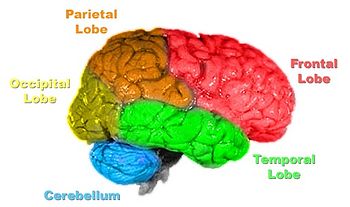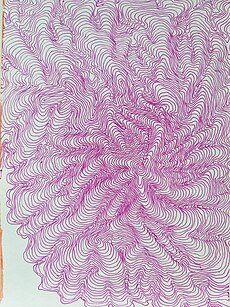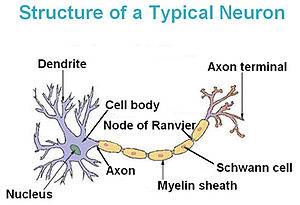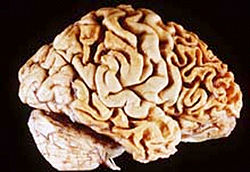Brain: Difference between revisions
imported>Gareth Leng |
imported>Gareth Leng |
||
| Line 61: | Line 61: | ||
===Function=== | ===Function=== | ||
Vertebrate brains receive signals through nerves arriving from the sensors of the organism. These signals are then processed throughout the central nervous system; reactions are formulated based upon reflex and learned experiences. A similarly extensive nerve network delivers signals from a brain to control important muscles throughout the body. Anatomically, | Vertebrate brains receive signals through nerves arriving from the sensors of the organism. These signals are then processed throughout the central nervous system; reactions are formulated based upon reflex and learned experiences. A similarly extensive nerve network delivers signals from a brain to control important muscles throughout the body. Anatomically, most afferent and efferent nerves (with the exception of the [[cranial nerves]]) are connected to the spinal cord, which carries signals to and from the brain and the rest of the body. | ||
Sensory input is processed by the brain to recognize danger, find food, identify potential mates, and perform more sophisticated functions. [[Vision|Visual]], touch, and [[hearing (sense)|auditory]] sensory pathways of vertebrates are routed to specific nuclei of the [[thalamus]] and then to regions of the cerebral cortex that are specific to each [[sensory system]]. The [[visual system]], the [[auditory system]], and the [[somatosensory system]]. Olfactory pathways are routed to the olfactory bulb, then to various parts of the [[olfactory system]]. [[Taste]] is routed through the brainstem and then to other portions of the [[gustatory system]]. | Sensory input is processed by the brain to recognize danger, find food, identify potential mates, and perform more sophisticated functions. [[Vision|Visual]], touch, and [[hearing (sense)|auditory]] sensory pathways of vertebrates are routed to specific nuclei of the [[thalamus]] and then to regions of the cerebral cortex that are specific to each [[sensory system]]. The [[visual system]], the [[auditory system]], and the [[somatosensory system]]. Olfactory pathways are routed to the olfactory bulb, then to various parts of the [[olfactory system]]. [[Taste]] is routed through the brainstem and then to other portions of the [[gustatory system]]. | ||
To control movement the brain has several parallel systems of muscle control. The motor system controls voluntary muscle movement, aided by the [[motor cortex]], [[cerebellum]], and the [[basal ganglia]]. The system eventually projects to the spinal cord and then out to the muscle effectors. Nuclei in the | To control movement, the brain has several parallel systems of muscle control. The motor system controls voluntary muscle movement, aided by the [[motor cortex]], [[cerebellum]], and the [[basal ganglia]]. The system eventually projects to the spinal cord and then out to the muscle effectors. Nuclei in the brainstem control many involuntary muscle functions such as heart rate and breathing. In addition, many automatic acts (simple reflexes, locomotion) can be controlled by the spinal cord alone. | ||
It is hypothesized that | It is hypothesized that in the brains of humans, consciousness emerges from the massively complex interactions between the numerous systems within the brain. Cognitive processing in mammals occurs in the cerebral cortex but relies on midbrain and [[limbic system|limbic]] functions as well. Among "younger" (in an evolutionary sense) vertebrates, advanced processing involves progressively rostral (forward) regions of the brain. | ||
Hormones, incoming sensory information, and cognitive processing performed by the brain determine the brain state. | Hormones, incoming sensory information, and cognitive processing performed by the brain determine the brain state. Stimuli from any source can trigger a general arousal process that focuses cortical operations to processing the new information. This focusing of cognition is known as [[attention]]. Cognitive priorities are constantly changed by factors such as hunger, fatigue, belief, unfamiliar information, or threat. The simplest dichotomy related to the processing of threats is the [[fight-or-flight response]] mediated by the [[amygdala]] and other limbic structures. | ||
===Brain pathology=== | ===Brain pathology=== | ||
Revision as of 10:45, 9 January 2007
Template:Dablink Template:Portalpar The brain, or encephalon (Greek for "in the head"), is the control center of the central nervous system. In vertebrates, the brain is located in the head, protected by the skull and close to the primary sensory apparatus of vision, hearing, taste and olfaction. While all vertebrates have a brain, invertebrates have either a centralized brain or collections of individual ganglia. Brains can be extremely complex; the human brain contains more than 100 billion neurons, each linked to as many as 10,000 others.[1]
Overview
Most brains exhibit a visible distinction between grey matter, which consists of the cell bodies of the nerve cells (neurons), and white matter, which consists of the fibers (axons) that connect them. The axons are surrounded by a fatty insulating sheath called myelin, giving the white matter its color. The topmost outer layer of the mammalian brain is grey matter called cerebral cortex. Deep in the brain, compartments of white matter (fasciculi, fiber tracts), grey matter (nuclei) and spaces filled with cerebrospinal fluid (ventricles) are found.
The brain innervates the head through cranial nerves, and is continuous with the spinal cord, which innervates the body through spinal nerves. Fibers transmitting signals from the brain are called efferent fibers, and fibers transmitting signals to the brain are called afferent (or sensory) fibers. The brain controls a wide variety of functions. It is the site of reason and intelligence, which include such components as cognition, perception, attention, memory and emotion. The brain is also responsible for control of posture and movements. It makes possible cognitive, motor and other forms of learning. The brain performs many functions automatically, without the need for conscious awareness, such as controlling hormone secretion and homeostatic functions such as control of heart rate, blood pressure, respiration (breathing), fluid balance, and body temperature.
Neurons are the electrically active brain cells that process information, but are outnumbered in the brain by Glial cells which perform a wide range of important supporting functions. Neurons use considerable amounts of energy; as well as being electrically active, neurons must constantly synthesise neurotransmitters - the chemical messengers by which neurons 'talk' to each other.
The study of the brain is known as neuroscience.
History
Early human views on the function of the brain regarded it to be a form of “cranial stuffing” . In Egypt, from the late Middle Kingdom onwards, in preparation for mummification, the brain was regularly removed, for it was the heart that was assumed to be the seat of intelligence. According to Herodotus, during the first step of mummification: ‘The most perfect practice is to extract as much of the brain as possible with an iron hook, and what the hook cannot reach is mixed with drugs.’ Over the next five-thousand years, this view came to be reversed; the brain is now known to be the seat of intelligence, although colloquial variations of the former remain as in “memorizing something by heart”.
Mind and brain
Template:Portalpar A distinction is often made in the philosophy of mind between the mind and the brain, and there is some controversy as to their exact relationship, leading to the mind-body problem. The brain is defined as the physical and biological matter contained within the skull, responsible for all electrochemical neuronal processes. The mind, however, is seen in terms of mental attributes, such as beliefs or desires. Some believe that the mind exists in some way independently of the brain, such as in a soul or epiphenomenon. Others, such as strong AI theorists, say that the mind is directly analogous to computer software and the brain to hardware.
Comparative anatomy
Three groups of animals have notably complex brains: the arthropods (insects and crustaceans), the cephalopods (octopuses, squids, and similar mollusks), and the craniates (vertebrates).[2] The brain of arthropods and cephalopods arises from twin parallel nerve cords that extend through the body of the animal. Arthropods have a central brain with three divisions and large optical lobes behind each eye for visual processing.[2]
The brain of craniates develops from the anterior section of a single dorsal nerve cord, which later becomes the spinal cord.[3] In craniates, the brain is protected by the bones of the skull. In vertebrates, increasing complexity in the cerebral cortex correlates with height on the phylogenetic and evolutionary tree. Primitive vertebrates such as fish, reptiles, and amphibians have fewer than six layers of neurons in the outer layer of their brains. This cortical configuration is called the allocortex (or heterotypic cortex).
More complex vertebrates including mammals have a six-layered neocortex (or homotypic cortex, neopallium), in addition to having some parts of the brain that are allocortex. In mammals, increasing convolutions of the brain are characteristic of animals with more advanced brains. These convolutions provide a larger surface area for a greater number of neurons while keeping the volume of the brain compact enough to fit inside the skull. The folding allows more grey matter to fit into a smaller volume, similar to a really long slinky being able to fit into a tiny box when completely pushed together. The folds are called gyri, while the spaces between the folds are called sulci.
Although the general histology of the brain is similar from person to person, the structural anatomy can differ. Apart from the gross embryological divisions of the brain, the location of specific gyri and sulci, primary sensory regions, and other structures differs between species.
Invertebrates
In insects, the brain has four parts, the optical lobes, the protocerebrum, the deutocerebrum, and the tritocerebrum. The optical lobes are behind each eye and process visual stimuli. The protocerebrum contains the mushroom bodies, which respond to smell, and the central body complex. In some species such as bees, the mushroom body receives input from the visual pathway as well. The deutocerebrum includes the antennal lobes, which are similar to the mammalian olfactory bulb, and the mechanosensory neuropils which receive information from touch receptors on the head and antennae. The antennal lobes of flies and moths are quite complex.
In cephalopods, the brain has two regions: the supraesophageal mass and the subesophageal mass, separated by the esophagus. The supra- and subesophageal masses are connected to each other on either side of the esophagus by the basal lobes and the dorsal magnocellular lobes. The large optic lobes are sometimes not considered to be part of the brain, as they are anatomically separate and are joined to the brain by the optic stalks. However, the optic lobes perform much visual processing, and so functionally are part of the brain.
Vertebrates

The telencephalon (cerebrum) is the largest region of the mammalian brain; it is the structure most easily visible in brain specimens, and what most people associate with the 'brain'. In humans and several other animals, the fissures (sulci) and convolutions (gyri) give the brain a wrinkled appearance. In non-mammalian vertebrates with no cerebrum, the metencephalon is the highest center in the brain. Because humans walk upright, there is a flexure, or bend, in the brain between the brain stem and the cerebrum. Other vertebrates do not have this flexure.
Behind (or in humans, below) the cerebrum is the cerebellum. The cerebellum is involved in the control of movement, and is connected by thick white matter fibers (cerebellar peduncles) to the pons. The cerebrum and the cerebellum each have two hemispheres. The telencephalic hemispheres are connected by the corpus callosum, another large white matter tract. An outgrowth of the telencephalon called the olfactory bulb is a major structure in many animals, but in humans and other primates it is relatively small, this structure processes information arising from the sense of smell.
Vertebrate nervous systems are distinguished by bilaterally symmetrical encephalization. Encephalization refers to the tendency for more complex organisms to gain larger brains through evolutionary time. Larger vertebrates have a complex, layered and interconnected neuronal circuitry. In modern species most closely related to the first vertebrates, brains are covered with gray matter that has a three-layer structure (allocortex). Their brains also contain deep brain nuclei and fiber tracts forming the white matter. Most regions of the human cerebral cortex have six layers of neurons (neocortex).
Humans
The structure of the human brain differs from that of other animals in several important ways. These differences allow for many abilities over and above those of other animals, such as the ability to use language to express thoughts and communicate with others. In humans, the neocortex, the most complex part of the cerebral cortex, is particularly large compared with other animals. especially to the prefrontal cortex. Although humans have some unique neural capacities, but much of their brain structure is similar to that of other mammals. Basic systems that alert the nervous system to stimulus, that sense events in the environment, and monitor the condition of the body are similar to those of even non-mammalian vertebrates.
Neurobiology
The brain is composed of two broad classes of cells, neurons and glia, both of which contain several different cell types which perform different functions. Interconnected neurons form neural networks (or neural ensembles). These networks are similar to man-made electrical circuits in that they contain circuit elements (neurons) connected by biological wires (nerve fibers). These do not form simple one-to-one electrical circuits like many man-made circuits, however. Typically neurons connect to at least a thousand other neurons. These highly specialized circuits make up systems which are the basis of perception, different types of action, and higher cognitive function.
Histology
Neurons are the cells that generate action potentials and convey information to other cells; these constitute the essential class of brain cells. In addition to neurons, the brain contains glial cells in a roughly 10:1 proportion to neurons. Glial cells ("glia" is Greek for “glue”) form a complex and sophisticted support system for neurons. They create the insulating myelin, provide structure to the neuronal network, manage waste, and clean up neurotransmitters. Most types of glia in the brain are present in the entire nervous system. Exceptions include the oligodendrocytes which myelinate neural axons (a role performed by Schwann cells in the peripheral nervous system). The myelin in the oligodendrocytes insulates the axons of some neurons. White matter in the brain is myelinated neurons, while grey matter contains mostly cell soma, dendrites, and unmyelinated portions of axons and glia. The space between neurons is filled with dendrites as well as unmyelinated segments of axons; this area is referred to as the neuropil.
In mammals, the brain is surrounded by connective tissues called the meninges, a system of membranes that separate the skull from the brain. This three-layered covering is composed of (from the outside in) the dura mater, arachnoid mater, and pia mater. The arachnoid and pia are physically connected and thus often considered as a single layer, the pia-arachnoid. Below the arachnoid is the subarachnoid space which contains cerebrospinal fluid, a substance that protects the nervous system. Blood vessels enter the central nervous system through the perivascular space above the pia mater. The cells in the blood vessel walls are joined tightly, forming the blood-brain barrier which protects the brain from toxins that might enter through the blood.
The brain is bathed in cerebrospinal fluid (CSF), which circulates between layers of the meninges and through cavities in the brain called ventricles. It is important both chemically for metabolism and mechanically for shock-prevention. For example, the human brain weighs about 1-1.5kg; its mass and density are such that it will begin to collapse under its own weight. The CSF allows the brain to float, easing the physical stress caused by the brain’s mass.
Function
Vertebrate brains receive signals through nerves arriving from the sensors of the organism. These signals are then processed throughout the central nervous system; reactions are formulated based upon reflex and learned experiences. A similarly extensive nerve network delivers signals from a brain to control important muscles throughout the body. Anatomically, most afferent and efferent nerves (with the exception of the cranial nerves) are connected to the spinal cord, which carries signals to and from the brain and the rest of the body.
Sensory input is processed by the brain to recognize danger, find food, identify potential mates, and perform more sophisticated functions. Visual, touch, and auditory sensory pathways of vertebrates are routed to specific nuclei of the thalamus and then to regions of the cerebral cortex that are specific to each sensory system. The visual system, the auditory system, and the somatosensory system. Olfactory pathways are routed to the olfactory bulb, then to various parts of the olfactory system. Taste is routed through the brainstem and then to other portions of the gustatory system.
To control movement, the brain has several parallel systems of muscle control. The motor system controls voluntary muscle movement, aided by the motor cortex, cerebellum, and the basal ganglia. The system eventually projects to the spinal cord and then out to the muscle effectors. Nuclei in the brainstem control many involuntary muscle functions such as heart rate and breathing. In addition, many automatic acts (simple reflexes, locomotion) can be controlled by the spinal cord alone.
It is hypothesized that in the brains of humans, consciousness emerges from the massively complex interactions between the numerous systems within the brain. Cognitive processing in mammals occurs in the cerebral cortex but relies on midbrain and limbic functions as well. Among "younger" (in an evolutionary sense) vertebrates, advanced processing involves progressively rostral (forward) regions of the brain.
Hormones, incoming sensory information, and cognitive processing performed by the brain determine the brain state. Stimuli from any source can trigger a general arousal process that focuses cortical operations to processing the new information. This focusing of cognition is known as attention. Cognitive priorities are constantly changed by factors such as hunger, fatigue, belief, unfamiliar information, or threat. The simplest dichotomy related to the processing of threats is the fight-or-flight response mediated by the amygdala and other limbic structures.
Brain pathology
Clinically, death is defined as an absence of brain activity as measured by EEG. Injuries to the brain tend to affect large areas of the organ, sometimes causing major deficits in intelligence, memory, and movement. Head trauma caused, for example, by vehicle and industrial accidents, is a leading cause of death in youth and middle age. In many cases, more damage is caused by resultant swelling (edema) than by the impact itself. Stroke, caused by the blockage or rupturing of blood vessels in the brain, is another major cause of death from brain damage.
Other problems in the brain can be more accurately classified as diseases rather than injuries. Neurodegenerative diseases, such as Alzheimer's disease, Parkinson's disease, motor neurone disease, and Huntington's disease are caused by the gradual death of individual neurons, leading to decrements in movement control, memory, and cognition. Currently only the symptoms of these diseases can be treated. Mental illnesses, such as clinical depression, schizophrenia, bipolar disorder, and post-traumatic stress disorder are brain diseases that impact personality and, typically, other aspects of mental and somatic function. These disorders may be treated by psychiatric therapy, pharmaceutical intervention, or through a combination of treatments; therapeutic effectiveness varies significantly among individuals.
Some infectious diseases affecting the brain are caused by viruses and bacteria. Infection of the meninges, the membrane that covers the brain, can lead to meningitis. Bovine spongiform encephalopathy (also known as mad cow disease), is deadly in cattle and humans and is linked to prions. Kuru is a similar prion-borne degenerative brain disease affecting humans. Both are linked to the ingestion of neural tissue, and may explain the tendency in some species to avoid cannibalism. Viral or bacterial causes have been substantiated in multiple sclerosis, Parkinson's disease, Lyme disease, encephalopathy, and encephalomyelitis.
Some brain disorders are congenital. Tay-Sachs disease, Fragile X syndrome, and Down syndrome are all linked to genetic and chromosomal errors. Malfunctions in the embryonic development of the brain can be caused by genetic factors, by drug use, and disease during a mother's pregnancy.
Study of the brain
Neuroscience seeks to understand the nervous system, including the brain, from a biological and computational perspective. Psychology seeks to understand behavior and the brain. The terms neurology and psychiatry usually refer to medical applications of neuroscience and psychology respectively. Cognitive science seeks to unify neuroscience and psychology with other fields that concern themselves with the brain, such as computer science (artificial intelligence and similar fields) and philosophy.
Other matters
Computer scientists have produced simulated neural networks loosely based on the structure of neuron connections in the brain. Artificial intelligence seeks to replicate brain function—although not necessarily brain mechanisms—but as yet has been met with limited success. Creating algorithms to mimic a biological brain is very difficult because the brain is not a static arrangement of circuits, but a network of vastly interconnected neurons that are constantly changing their connectivity and sensitivity. More recent work in both neuroscience and artificial intelligence models the brain using the mathematical tools of chaos theory and dynamical systems. Current research has also focused on recreating the neural structure of the brain with the aim of producing human-like cognition and artificial intelligence.
References
- ↑ Chudler, Eric H. (2006). Brain Facts and Figures. Neuroscience for Kids. Retrieved on May 19, 2006.
- ↑ 2.0 2.1 Butler, Ann B. (2000). "Chordate Evolution and the Origin of Craniates: An Old Brain in a New Head". The Anatomical Record 261: 111–125.
- ↑ Kandel, ER; Schwartz JH, Jessell TM (2000). Principles of Neural Science, 4th ed.. New York: McGraw-Hill. ISBN 0-8385-7701-6.
External links
- Brain Tutorial
- Comparative Mammalian Brain Collection
- Brain Research News from ScienceDaily
- BrainInfo for Neuroanatomy
- Neuroscience for kids
- Everything you wanted to know about the brain — Provided by New Scientist.
- Fact sheets on brain injury - causes, effects and coping strategies
- BrainMaps.org, interactive high-resolution digital brain atlas based on scanned images of serial sections of both primate and non-primate brains
- Scientific American Magazine (September 2003 Issue) Ultimate Self-Improvement
- An orderly article about the brain
- Brain Training



